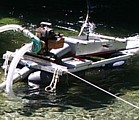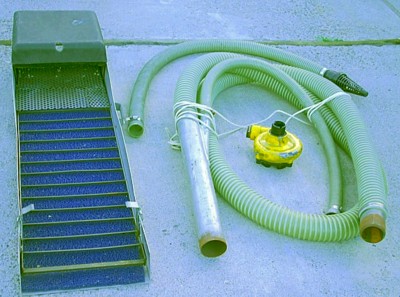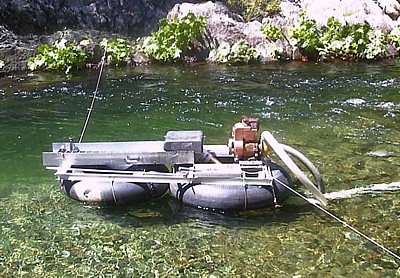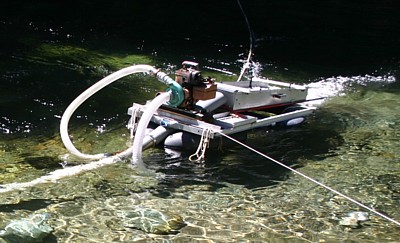Build A Do It Yourself,
Home Made
Suction Dredge

.

Build A Do It Yourself,
|
 |
||
|
. |
Interested in building your own suction dredge gold prospecting and saving some significant money in the process? If you do it right and plan well you really can save a lot of money and still have a good, functional dredge that is durable and really holds onto the gold - and that counts for a lot. Here are some thoughts about the essential tools, components and skills that you need to take a look at when planning out the construction of your own home built gold suction dredge...... |
 |
|
No question that many gold prospectors would love to own a dredge, and dredges are very cool pieces of prospecting equipment that will allow you to mine some very nice gold nuggets, but the prices for new ones are really high. Don’t forget however, that in the earliest days of dredging, there were no manufacturers, and all small suction dredges were handcrafted units made in someone's garage. There's no question that a good dredge can be made at home, and I know you can save some significant money doing it, because I've done it myself. Building a dredge is a big project with a lot of plans and decisions to be made. Take your time and think about what you really want to build. Think about what materials you have on hand or what you could easily acquire, then build a list of what you need to construct your dredge. Unfortunately, a simple set of dredge plans that would work for all sizes of suction dredges is just impossible, so I've not tried to prepare any such thing. However, you can do it for your project. If you really sit down and think about things, and use measurements taken from the commercial dredge makers you can design your own set of plans for your specific dredge project. |
|
|
Of course you will be building on the cheap, but
you don't want to shortchange yourself too much. You
don't want your dredge to be rickety, or to fall apart, or to fail to function.
Dredges
need to be functional, durable and sturdy. The
time you spend sorting through design concepts, deciding what you will build and how you
will build it will be well spent. Think about
what you want and what you need then weigh those together with what you can afford. Do up some drawings and lists. Perhaps the best thing I can suggest is that you
study the designs of the well-known dredge makers like Keene and Pro-line. These
manufacturers have done quite a bit of research studying their products, they have tested
different options and have developed efficient pieces of equipment that do the job well.
Check out their web sites as most have good photos of their dredges and the individual
components that make up these dredges – you can get a lot of information from their
web sites. If your local prospecting shop has a dredge set up, take a close look and even
measurements or photos if you can. Another great possibility is to join a prospecting club
whose members actively dredge, and then go out to the claims and check out the members
while they are dredging. Take some pictures of the dredges while they're in operation. The club members may even let you have a few
minutes behind the nozzle so that you can get a feel for the whole experience. The more general knowledge you have about dredges
before you begin your design, the better your construction plans will be. |
 Sometimes good used dredge parts are available to start a homemade dredge. |
|
|
||
| When you are sitting down to plan the designs of your own home made gold dredge, probably the first question you will want to ask yourself is “What size of dredge do I want to build?” That is probably the first and most important decision. The bigger your suction dredge is, the more gold bearing material you'll be able to process, but the more it will cost and the more it will weigh. So weight and cost are the trade-offs for the volume you can process, and practically speaking, the depth of bedrock you will be able to reach. It is a general rule of dredges that it is not practical to dredge feet of overburden greater than the inside diameter of your hose in inches. So for a 2 inch dredge you don't want to go through overburden deeper than about 2 feet, for a 4 inch dredge you don't want to go through more than about 4 feet of overburden, and the 6 inch dredge would be limited to around 6 feet of overburden, etc. Of course this is just a rule of thumb and while it is possible to dredge a 10 foot deep hole with a 2 inch dredge, but it will take forever and be highly inefficient. This little rule of thumb does not count the depth of water, only the depth of gravel overburden down to bedrock. Another piece of design information to consider in your planning is that a four or five inch dredge is about as big as one guy can handle efficiently by himself. If you're really big, tough and young you may be able to handle a 6-inch by yourself, but it will tax you. A 4-inch is probably the best size for a single guy operation. That's the boat I am in and I've mined some pretty good gold nuggets over the years with the suction dredges I have owned. | ||
Will you need compressed air for diving? If so, you will need an air compressor, an air receiving tank and related diving equipment. Air is really handy to have, but its optional, and you can always add air later if you plan well and allow space for the compressor on your dredge. Your homemade dredge will need a motor and a pump. If you want to dive, you will also need a compressor. I have developed a page to consider and discuss the purchase Mining Equipment component parts and elements. Before you make that buy, check it out at: Mining Equipment Component Parts Do you have the proper tools? Fabricating your own suction dredge takes tools. Things like a hack saw, pop rivet gun, drills, wrenches and the like are the minimum. Do you actually have the experience to build such a project? The more tools and fabricating skills you possess, the more likely it is that your home made dredge project will be a success. I have done up a page on hand tools for this type of project, you can check it out at: Mining Project Necessary Tools Having the ability to do some arc welding, or to bend and shear cut metal are also handy abilities to possess. My little 120V arc welder, while underpowered, has helped me complete some serious fabrication projects. If you don’t already own a welder, this project might be just the excuse you needed to buy one! I so strongly recommend that you consider buying one of these welders that I have done up a whole web page on it. If you are seriously considering building your own dredge, check out my page: Low Cost, Small Arc Welders For Home Use |
 An earlier incarnation of my dredge, with the old crash box sluice from Keene. |
|
| Count the cost and figure what is realistically possible:
It’s not free! You can save a lot of money building your own home made
gold dredge, but it
still won't be cheap. I strongly recommend that before you actually begin to buy materials
that you sit down with your design plan and figure those costs. Be sure you have enough money to complete your
project. I decided to buy some parts from Keene, because I didn’t think I could
fabricate an item as good as what they had to offer. On the other hand, I bought some used
dredge components as well. All in all my 4 inch dredge cost less than 1/3 of what a new
one would cost. Here are some of my comment on deciding what you will do for yourself and what you will buy: Near Impossible to make (but you might them get used): Engine: Water Pump: |
||
|
|
||
Air
Compressor:
Hose: |
 |
Recommended Metal Detectors For Gold Prospecting:
|
Do-able With Some Effort: Sluice Box: Header / crash box / flare: Jet: Nozzle: |
||
Flotation: Nowadays, most commercial suction dredges are built on plastic
pontoons. They are more durable but they are also a lot heavier. There are a number of options in this direction as
well. I have seen homemade dredges built on a
variety of plastic pontoons. One interesting
option is five to 10 gallon sized plastic shipping containers or barrels. Sometimes these can be purchased quite cheaply. Another option is to purchase the pontoons from
the manufacturer, but in general these are quite expensive. The other part of the flotation system is the frame or mount for the sluice box and motor, allowing them to sit in a stable manner on top of your flotation units. I made my frame out of scrap aluminum purchased at the local junkyard. It was inexpensive and not difficult to construct. Because it was flat it sat easily upon my truck tubes. Foot valve: |
||
You will also need a wet suit of some sort, although the actual type depends on where you will be dredging for gold. Even in California in midsummer the water gets awfully cold after an hour or two if you do not have some sort of protection. In Alaska, much more serious protection such as a well-designed dry suit is needed so that you can stay in the water while operating your dredge. I have found that the junk yard / recycling yard can provide some important pieces that you may use at low prices. I suggest that one you have made good plans for the suction dredge you want to build and are ready to get going on your porject, take your purchase list and go look through the local scrap yards - you can get stuff there a whole lot cheaper than you would at someplace like Home Depot. You may even find a suitable used engine there. I suggest that once you have assembled all the pieces you need, the next step is to put your new dredge all together and test it. I suggest that you test it with a couple dozen pieces of small lead bird shot. Flatten them, and paint them red or some other bright color. Then suck up some gravel from the nearest gold bearing stream and put the shot in with the gravel you are processing. Be sure to take in a good bit of gravel both before and after you've sucked up the shot. When you clean up the sluice, count how many of the shot you have recovered and compare that to the number you started with. You should not lose more than one or two at the most. If you lose more than three or four you need to adjust your dredge or make some changes to improve it so you can be confident you are not loosing gold nuggets. If you would like to look at some more info that I have done up
on using a gold dredge, including a diagram as to how a suction dredge works, take a look at:
I hope you have found this information on planning and designing your own home made dredge useful. I wish you the best of luck with your home made gold dredge project, remember to measure twice and cut only once! |
|
|
|
|
||
|
|
||
Want to know a little bit more about this crazy
prospector guy? Well, here's a little bit more about me, and how I got into prospecting: Chris'
Prospecting Story Interested
in seeing more gold? Here are some interesting photos of beautiful Gold Nuggets
Here you can learn about gold suction dredges, homemade gold dredges, gold dredge plans, gold dredge design, build your own gold dredge, consider buying a used gold dredge, suction dredge, dredge equipment, small gold dredge, portable gold dredges, dredge gold mining, mining dredge, dredge pump, gold dredge for sale, placer mining, gold nuggets, gold flakes.